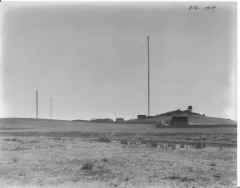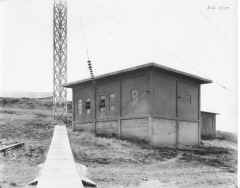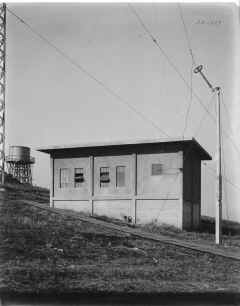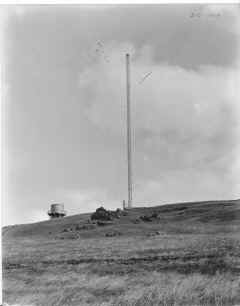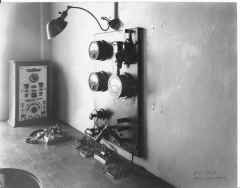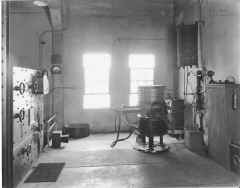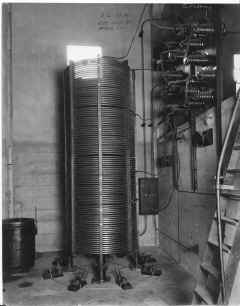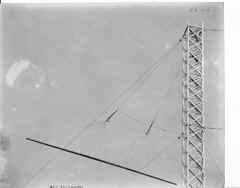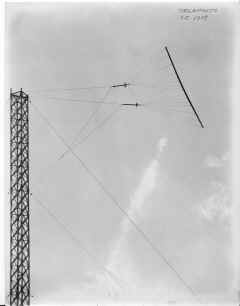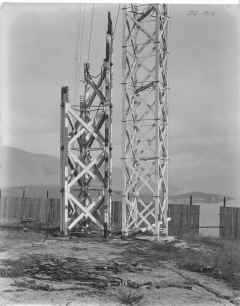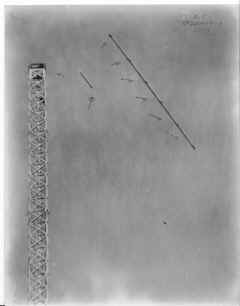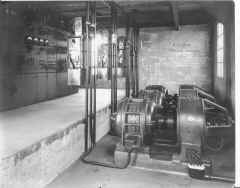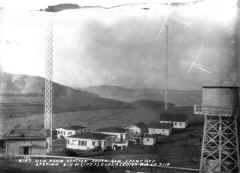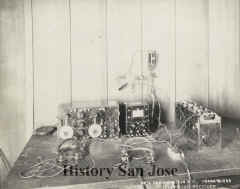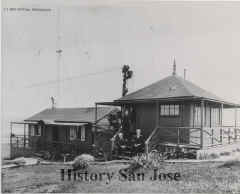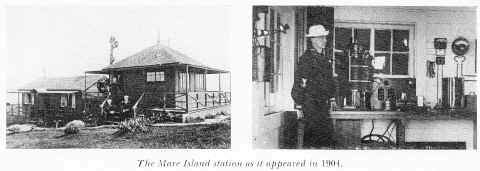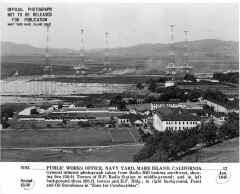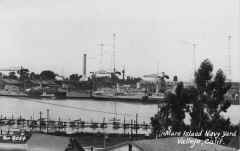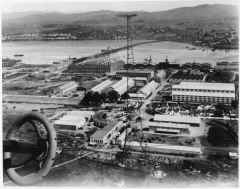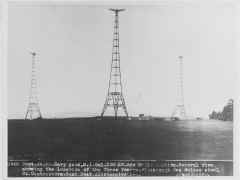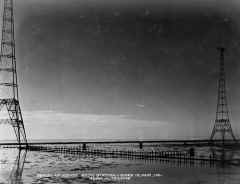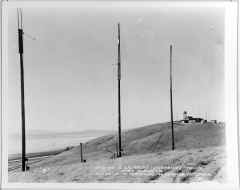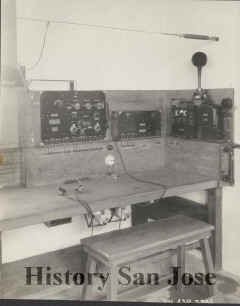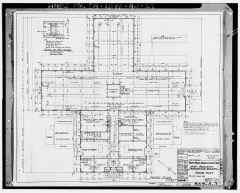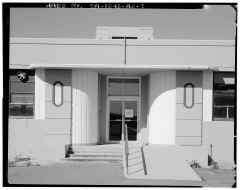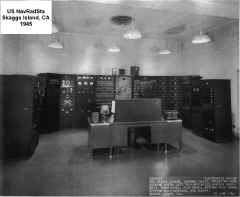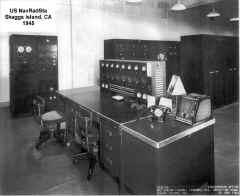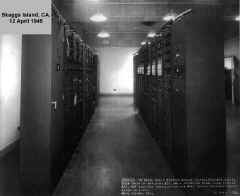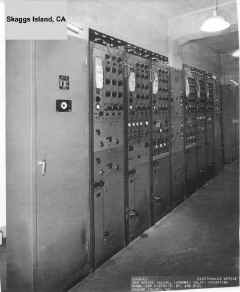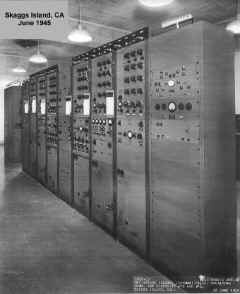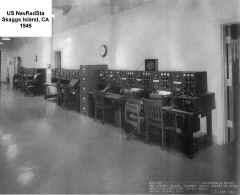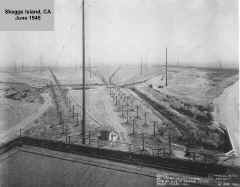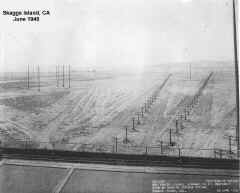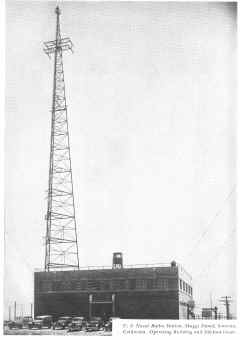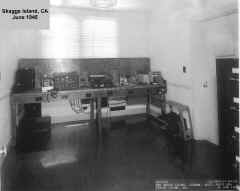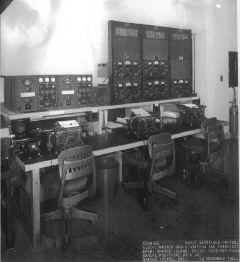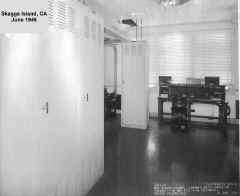The first equipment consisted of a Slaby-Arco open-gap spark transmitter together with a Slaby-Arco coherer and decoherer for receiving, which had been purchased from the German General Electric Company and shipped to the Mare Island Navy Yard for installation . The first call sign used was "MI" which was probably self-assigned as the first officially assigned call sign was "TG".
The Yerba Buena station (Goat Island) was commissioned May 5, 1904. The first official call sign was "TI." [Photos]
In 1915, 30 KW arc transmitters were installed at Mare Island. A decision was made to establish the Yerba Buena Station as the control station and Mare Island as the transmitter station for the communication complex. At that time the Mare Island station was changed from a transmitting/receiving station to a transmitting station only, with control (keying) of the transmitters accomplished by the Yerba Buena Station (NPG). The San Francisco District consisted of the stations at Yerba Buena Island (District Center), Mare Island, Farallon Island, Eureka, Marshfield and a station at Monterey which had been authorized but was never built.
During WW1, the Navy acquired Federal Telegraph KSS in South San Francisco. [Photos] It was equipped with one 30 KW and one 40 KW arc transmitters, and operated from Yerba Buena. [Photos] In 1919, the 40 KW arc transmitter was installed at Mare Island (HIPOWER) along with a 100 KW arc transmitter from Tuckerton NJ. An additional 100KW arc transmitter was installed at Mare Island in 1922. [Photos]
In April 1917 the Navy also took over the Marconi station KPH at Hillcrest (Daly City). It was equipped with a 5KW quenched gap spark set. [Photos]
In addition, the Navy took over the Federal station KFS located on the beach, which had a 12 KW arc transmitter. [Photos]
After the commercial stations in the San Francisco district were acquired by the Navy, for all purposes of operation and organization, the Yerba Buena, Mare Island, South San Francisco, Beach, and Hillcrest stations were known collectively as the San Francisco Naval Radio Station . The San Francisco station was both the main station of the Pacific Division and the district center station of the San Francisco Communication District .
In May 1923, the Yerba Buena Control Station was moved to the Appraisers Building in San Francisco. At the same time, a new receiver station was established at South San Francisco where signals received from Washington and Honolulu were piped into the control station in the Appraisers Building over lines leased from the Pacific Telephone Co . Signals from San Diego, Puget Sound, the direction finder stations and ships were received directly on receivers installed in the Appraisers Building.
In 1925 NPG moved to the newly constructed Marine Corps warehouse building in the industrial section of San Francisco, at 100 Harrison St.. Signals from Washington and Honolulu were piped into NPG from the receiver station at South San Francisco. Receivers, and antennas on the roof, were installed in the building for the San Diego, Puget Sound, DirectionĚ Finder Stations, and the ship-shore circuits. Operating positions for duplex operation of the Washington and Honolulu circuits and for the other circuits were located around a large room with desks for the traffic chief, supervisor, and local delivery clerk.
In 1935, NPG was moved to the newly constructed Federal Office Building in the Civic Center, San Francisco, where it remained for the next twenty-five years . From 1935 until the start of World War II, NPG consisted of the Radio Control Station in the Federal Office Building, the Radio Transmitting Station at Mare Island, the Time and Diversity Receiving Station at Mare Island, the Radio Monitor and Receiving Station at South San Francisco, and several Direction Finder stations. NPG control occupied a few rooms on the third floor of the building, where operating positions were located along a conveyor belt which carried messages between the operators and the supervisor and. traffic chief. High speed Kleinschmidt and Boehme tape equipments were used on the primary circuits to Washington and Honolulu. A few receivers were installed for the San Diego-Puget Sound circuit, the DF stations, and the ship-shore circuits. Photos
With the increase of communication circuits and the requirement for a better, noise-free location, the Radio Receiving site at Skaggs Island was developed and construction started in 1938 . Naval Radio Station (R). Skaggs Island, on the northern edge of San Francisco Bay, became a component part of NPG in 1942 as replacement for the old South San Francisco receiving station. [1945 Photos] All of Mare Island's radio receiving functions were also shifted to the new station in 1942. Initial use of' the 3300 acre site was to provide receiving facilities for point to point, ship shore, local harbor, and inter and intra-district nets as the occasion demanded. Supplementary Radio (later NAVSECGRU) activities were added at Skaggs Island [more photos and info]
In 1962, NAVCOMMSTA San Francisco moved to Stockton (Rough and Ready Island). [1970's Stockton Photos]
In 1965, Transmitter operations were moved from Mare Island to NAVRADSTA (T) Dixon [info, photos]
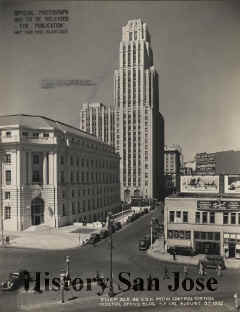
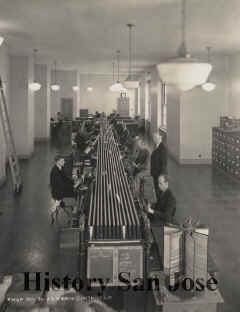
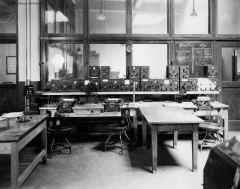
Another view of Marine Receiving Table
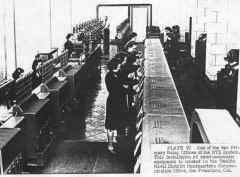
US Naval Radio Station Yerba Buena - NPG
More interior photos - More exterior photos
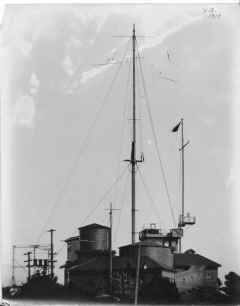
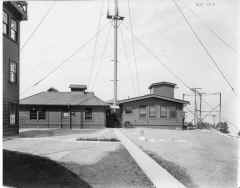
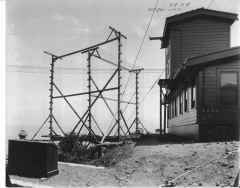
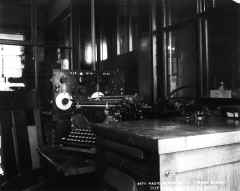
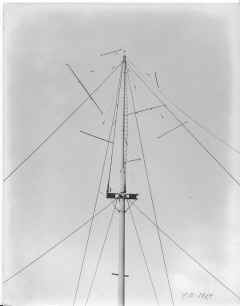

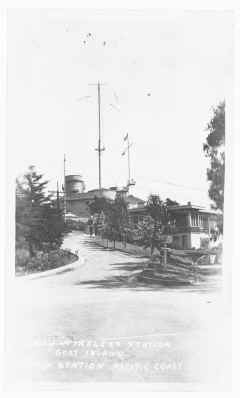
Short Wave Transmitter

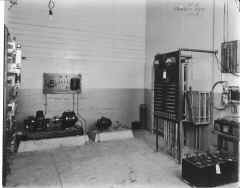

US Naval Radio Station Hillcrest - KPH (NWO?) -
Located in Daly City. Equipped with one 5 KW, 500 cycle quenched gap spark transmitter. The working wave was 600 meters . The set was also adjusted to
300 meters. Formerly a Marconi Company marine station, this station was taken over by the Navy on April 9, 1917 and operated for handling
ship-shore commercial traffic. It was an important station and handled a considerable
amount of traffic. The control of the transmitter was transferred to the Yerba Buena
station in 1918. This station was acquired by the Government by purchase and all properties were
transferred to the Government as of 15 May 1918.
- 1919 photos thanks to Gloria Conley
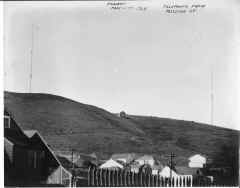
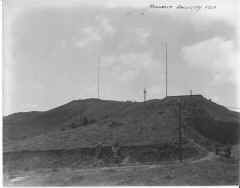
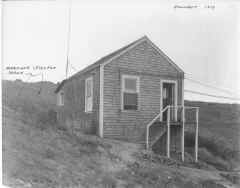

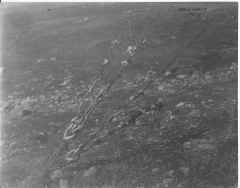
US Naval Radio Station, Beach (San Francisco) - KFS
Located on the ocean beach at Great Highway and Noriega Street and 48th Avenue in San Francisco. Equipped with one 12 KW arc transmitter adjusted for 3000, 3350, 3500, 4000, and 4500 meters. The working wave was 3500 meters. The station was formerly utilized by the Federal Telegraph Company for point to point traffic with Lents and Inglewood, and with ships equipped with arc sets. The Navy utilized the station for handling commercial traffic with ships. The station was taken over by the Navy on April 7, 1917. Control of the transmitter was transferred to the Yerba Buena Naval Radio Station 25 February 1918. The station was acquired by the Government by purchase and all properties were transferred to the Government 15 May 1918. - 1919 photos thanks to Gloria Conley
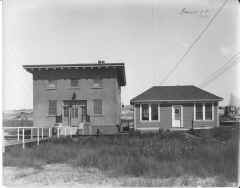
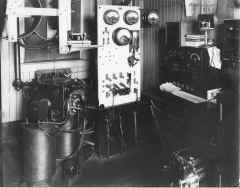

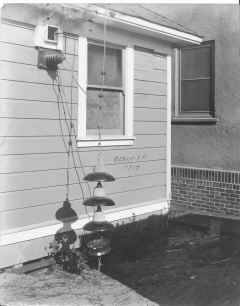
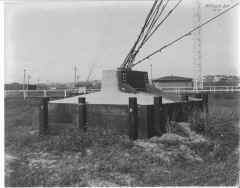
US Naval Radio Station South San Francisco - KSS
Formerly operated as a Federal Telegraph Company station with receiving and control station located in the Hobart Building in San Francisco. The transmitting station is located at South San Francisco and equipped with one 30 KW and one 40 KW arc transmitters, operated by remote control from the Hobart Building, adjusted for 6000, 8500, 10100, and 10600 meters. Until about 3PM the 10600 meter wave is used. During the afternoon, after 3PM, the 10100 meter wave is used . After 7 or 8PM, the 8500 meter wave is used. The 6000 meter wave is used as the last resort. Transpacific commercial traffic is handled between this station and the Heeia Point station in Hawaii. The Hobart Building control station was closed on February 25, 1918, and returned to the former owners . The control of the South San Francisco station was transferred to the Yerba Buena radio station. The South San Francisco station was acquired by the Government by purchase and all properties were transferred to the Government as of 15 May 1918. - 1919 photos thanks to Gloria Conley
